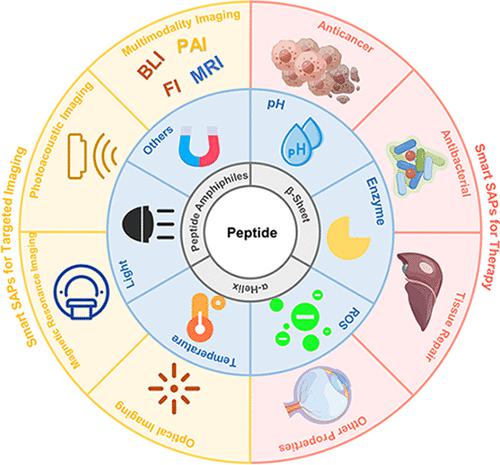Our official English website, www.x-mol.net, welcomes your
feedback! (Note: you will need to create a separate account there.)
Molecularly Stimuli-Responsive Self-Assembled Peptide Nanoparticles for Targeted Imaging and Therapy
ACS Nano ( IF 15.8 ) Pub Date : 2023-04-20 , DOI: 10.1021/acsnano.3c01452 Yang Zhou 1 , Qianqian Li 1, 2 , Ye Wu 1 , Xinyu Li 1 , Ya Zhou 1 , Zhu Wang 3 , Hui Liang 3 , Feiqing Ding 1 , Sheng Hong 1 , Nicole F Steinmetz 4 , Hui Cai 1
ACS Nano ( IF 15.8 ) Pub Date : 2023-04-20 , DOI: 10.1021/acsnano.3c01452 Yang Zhou 1 , Qianqian Li 1, 2 , Ye Wu 1 , Xinyu Li 1 , Ya Zhou 1 , Zhu Wang 3 , Hui Liang 3 , Feiqing Ding 1 , Sheng Hong 1 , Nicole F Steinmetz 4 , Hui Cai 1
Affiliation

|
Self-assembly has emerged as an extensively used method for constructing biomaterials with sizes ranging from nanometers to micrometers. Peptides have been extensively investigated for self-assembly. They are widely applied owing to their desirable biocompatibility, biodegradability, and tunable architecture. The development of peptide-based nanoparticles often requires complex synthetic processes involving chemical modification and supramolecular self-assembly. Stimuli-responsive peptide nanoparticles, also termed “smart” nanoparticles, capable of conformational and chemical changes in response to stimuli, have emerged as a class of promising materials. These smart nanoparticles find a diverse range of biomedical applications, including drug delivery, diagnostics, and biosensors. Stimuli-responsive systems include external stimuli (such as light, temperature, ultrasound, and magnetic fields) and internal stimuli (such as pH, redox environment, salt concentration, and biomarkers), facilitating the generation of a library of self-assembled biomaterials for biomedical imaging and therapy. Thus, in this review, we mainly focus on peptide-based nanoparticles built by self-assembly strategy and systematically discuss their mechanisms in response to various stimuli. Furthermore, we summarize the diverse range of biomedical applications of peptide-based nanomaterials, including diagnosis and therapy, to demonstrate their potential for medical translation.
中文翻译:

用于靶向成像和治疗的分子刺激响应自组装肽纳米颗粒
自组装已成为一种广泛使用的方法,用于构建尺寸从纳米到微米的生物材料。肽已被广泛研究用于自组装。由于其理想的生物相容性、生物降解性和可调结构,它们被广泛应用。基于肽的纳米粒子的开发通常需要涉及化学修饰和超分子自组装的复杂合成过程。刺激响应肽纳米粒子,也称为“智能”纳米粒子,能够响应刺激而发生构象和化学变化,已成为一类有前途的材料。这些智能纳米粒子具有广泛的生物医学应用,包括药物输送、诊断和生物传感器。刺激反应系统包括外部刺激(如光、温度、超声波和磁场)和内部刺激(如 pH 值、氧化还原环境、盐浓度和生物标志物),促进生成用于生物医学成像和治疗的自组装生物材料库。因此,在这篇综述中,我们主要关注通过自组装策略构建的基于肽的纳米粒子,并系统地讨论它们响应各种刺激的机制。此外,我们总结了基于肽的纳米材料的各种生物医学应用,包括诊断和治疗,以证明它们在医学转化方面的潜力。因此,在这篇综述中,我们主要关注通过自组装策略构建的基于肽的纳米粒子,并系统地讨论它们响应各种刺激的机制。此外,我们总结了基于肽的纳米材料的各种生物医学应用,包括诊断和治疗,以证明它们在医学转化方面的潜力。因此,在这篇综述中,我们主要关注通过自组装策略构建的基于肽的纳米粒子,并系统地讨论它们响应各种刺激的机制。此外,我们总结了基于肽的纳米材料的各种生物医学应用,包括诊断和治疗,以证明它们在医学转化方面的潜力。
更新日期:2023-04-20
中文翻译:

用于靶向成像和治疗的分子刺激响应自组装肽纳米颗粒
自组装已成为一种广泛使用的方法,用于构建尺寸从纳米到微米的生物材料。肽已被广泛研究用于自组装。由于其理想的生物相容性、生物降解性和可调结构,它们被广泛应用。基于肽的纳米粒子的开发通常需要涉及化学修饰和超分子自组装的复杂合成过程。刺激响应肽纳米粒子,也称为“智能”纳米粒子,能够响应刺激而发生构象和化学变化,已成为一类有前途的材料。这些智能纳米粒子具有广泛的生物医学应用,包括药物输送、诊断和生物传感器。刺激反应系统包括外部刺激(如光、温度、超声波和磁场)和内部刺激(如 pH 值、氧化还原环境、盐浓度和生物标志物),促进生成用于生物医学成像和治疗的自组装生物材料库。因此,在这篇综述中,我们主要关注通过自组装策略构建的基于肽的纳米粒子,并系统地讨论它们响应各种刺激的机制。此外,我们总结了基于肽的纳米材料的各种生物医学应用,包括诊断和治疗,以证明它们在医学转化方面的潜力。因此,在这篇综述中,我们主要关注通过自组装策略构建的基于肽的纳米粒子,并系统地讨论它们响应各种刺激的机制。此外,我们总结了基于肽的纳米材料的各种生物医学应用,包括诊断和治疗,以证明它们在医学转化方面的潜力。因此,在这篇综述中,我们主要关注通过自组装策略构建的基于肽的纳米粒子,并系统地讨论它们响应各种刺激的机制。此外,我们总结了基于肽的纳米材料的各种生物医学应用,包括诊断和治疗,以证明它们在医学转化方面的潜力。


















































 京公网安备 11010802027423号
京公网安备 11010802027423号